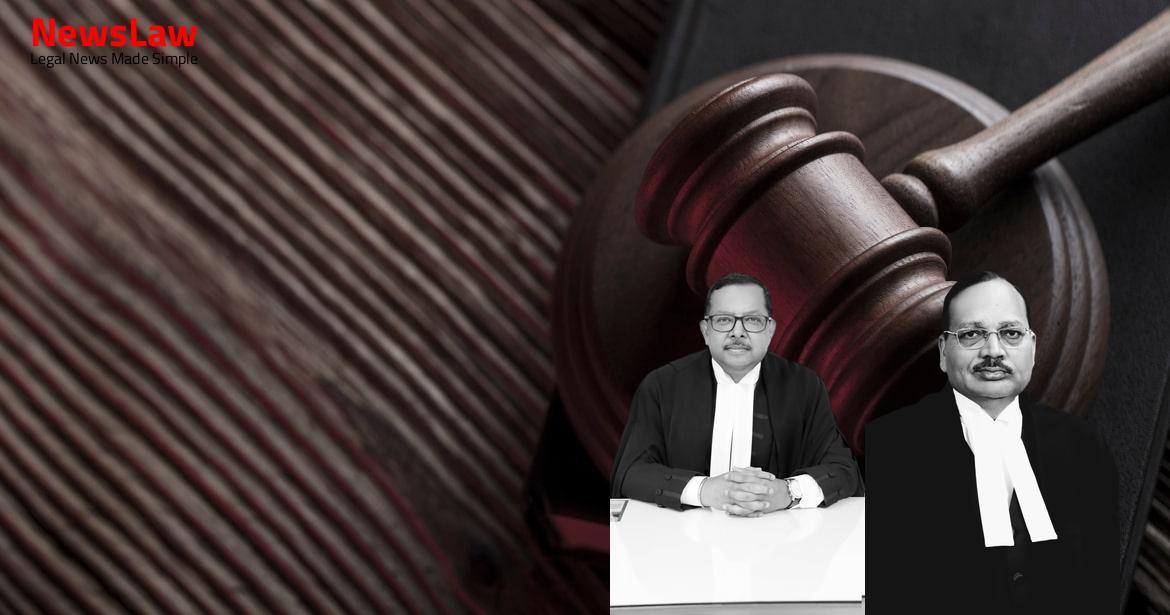In a landmark judgment, the Supreme Court of India has addressed the appeal in the Ganga Ghat Murder Case. The case involved the conviction of multiple accused persons, including the appellant, for their role in the murder of Satya Narain. The court delves into the intricacies of unlawful assemblies and vicarious liability, shedding light on the legal nuances surrounding such cases. This judgment marks a pivotal moment in criminal jurisprudence, solidifying the principles of accountability and justice.
Facts
- Appellant and other accused persons were convicted under Sections 147 and 302/149 IPC by the trial court.
- The High Court upheld the conviction and sentence of all accused, including the appellant.
- All accused persons, including the appellant, filed a criminal appeal under Section 374 of the Cr.P.C.
- Appellant was sentenced to undergo RI for two years and to pay a fine for the offences under Sections 147 and 302/149 IPC.
- The eyewitness account of the incident was corroborated by medical evidence, as observed by the High Court.
- The prosecution successfully proved its case against each accused beyond a reasonable doubt.
- Informant Sarwan Kumar and his family had a routine of going to the Ganga ghat for a bath on the fateful day.
- Accused persons Bhola Shankar and Kuldeep Kumar Tiwari confronted the deceased Satya Narain at the temple of Govardhan Nath Ji.
- Shree Dev and his sons, armed with weapons, assaulted Satya Narain leading to his death.
- Appellant Nitya Nand fired a country-made pistol during the assault.
- Accused persons fled the scene after the incident.
- Charges were framed under relevant sections of the IPC against the accused.
- The incident arose from an old enmity due to property dispute between the parties.
- Informant lodged an FIR leading to the registration of Crime No 237/1992 at P.S. Soron.
- The prosecution presented five witnesses and post-mortem report as evidence.
- Trial proceedings involved statements of the accused under Section 313 Cr.P.C.
Also Read: Speedy Trial Rights Upheld: Bail Granted in X vs. State of India
Issue
- Whether the prosecution could establish the culpability of the appellant in the murder of Satya Narain beyond any reasonable doubt?
- Whether the prosecution could prove the charges against the appellant under Sections 148 and 302/149 IPC beyond any reasonable doubt?
Also Read: Rizvi Committee Pay Scale Judgment: Upholding Justice and Equity
Arguments
- Appellant’s counsel argues that the trial court and High Court made errors in convicting the appellant under Sections 148 and 302/149 IPC.
- Key witness, Kuldeep Kumar Tiwari, was not examined by the prosecution, weakening the case.
- Laxmi Narain, a crucial witness, was not examined by the prosecution despite being with the deceased before the incident.
- Appellant’s conviction based solely on suspicion is deemed unjustified by the appellant’s counsel.
- Property dispute between Laxmi Narain and the deceased’s sons escalated, leading to the fatal incident.
- No recovery of country-made pistol or empty cartridge at the crime scene or elsewhere.
- Accused persons, including the appellant, fled after the appellant fired from his pistol.
- The state vehemently argues that the conviction and sentence of the appellant are justified.
- There was a clear motive for the accused persons, including the appellant, to murder Satya Narain.
- Witnesses stated that the appellant had a pistol and fired it in the air to intimidate others. The post-incident conduct of the appellant was also incriminating.
- The accused persons escaped from the crime scene and were involved in subsequent cases, indicating a premeditated plan.
- The submitted ocular evidence is supported by medical evidence, strengthening the case against the appellant.
- The counsel argues that the appellant was part of the unlawful assembly and present at the place of occurrence as mentioned in the FIR.
- The killing of an important eyewitness, Laxmi Narain, further supports the case against the appellant.
- Direct evidence establishes the appellant’s involvement in the murder of Satya Narain.
- The dispute over inheritance and the subsequent will made by Laxmi Narain in favor of Satya Narain’s sons fueled the resentment among the accused, including the appellant.
Also Read: High-Powered Sale Committee Formation for Asset Auction in Sai Group of Companies Case
Analysis
- The evidence of PW-1 and PW-2 establish the murder of Satya Narain by other accused persons under Section 302 IPC.
- The appellant is part of the unlawful assembly with a common object to kill the deceased.
- The testimony of eyewitnesses is supported by medical evidence, confirming the fatal injuries inflicted on Satya Narain.
- The appellant fired in the air to aid the accused persons in fleeing, solidifying his involvement in the unlawful assembly.
- Section 149 IPC invokes vicarious liability for crimes committed by any member of the assembly, including the appellant in this case.
- If an offence is committed by any member of an unlawful assembly in prosecution of the common object of that assembly, each member of the unlawful assembly is guilty of committing the offence.
- The provision under Section 149 IPC aims to prevent wrongdoers from claiming impunity by actively collaborating or assisting in the commission of offences.
- Liability under Section 149 IPC does not require every member of the unlawful assembly to commit the offence, mere knowledge of the likelihood of the offence being committed suffices.
- An assembly of five or more persons with a common object to commit an illegal act through criminal force constitutes an unlawful assembly.
- Section 148 IPC penalizes rioting while being armed with a deadly weapon, with imprisonment or fine or both.
- Section 149 IPC mandates that every member of an unlawful assembly shall be guilty of the offence committed in prosecution of the common object.
- Vicarious liability is established under Section 149 IPC for offences committed by any member of the unlawful assembly in furtherance of the common object, resulting in every member being held accountable.
- The court determines membership in an unlawful assembly, rather than active participation in the crime, to establish liability.
- The court’s focus is on whether the accused was a member of an unlawful assembly, not on their direct participation in the crime.
- Section 149 IPC does not create a separate offense but imposes vicarious liability on all assembly members for acts done with a common object.
- In cases of attacks by an unlawful assembly where multiple members are involved, it is not necessary for each accused to inflict injuries for liability.
- Presence in the unlawful assembly is sufficient for conviction under Section 149 IPC, overt acts are not required to be imputed to specific individuals.
- Section 149 is invoked to hold members of unlawful assemblies accountable even if they did not inflict fatal injuries, based on the evidence on record.
- The appellant was found to be part of an unlawful assembly that committed murder.
- Testimonies of PW-1 and PW-2 confirmed the appellant’s involvement in the unlawful assembly.
- Cross-examination did not weaken the testimonies of PW-1 and PW-2.
- The trial court’s conviction of the appellant under Section 148 IPC read with Section 302/149 IPC was deemed correct.
- The High Court’s confirmation of the conviction was justified.
Decision
- This part of the judgment discusses the appeal brought by the appellant.
- The court finds no merit in the appeal and dismisses it accordingly.
Case Title: NITYA NAND Vs. STATE OF UTTAR PRADESH (2024 INSC 655)
Case Number: Crl.A. No.-001348-001348 – 2014



